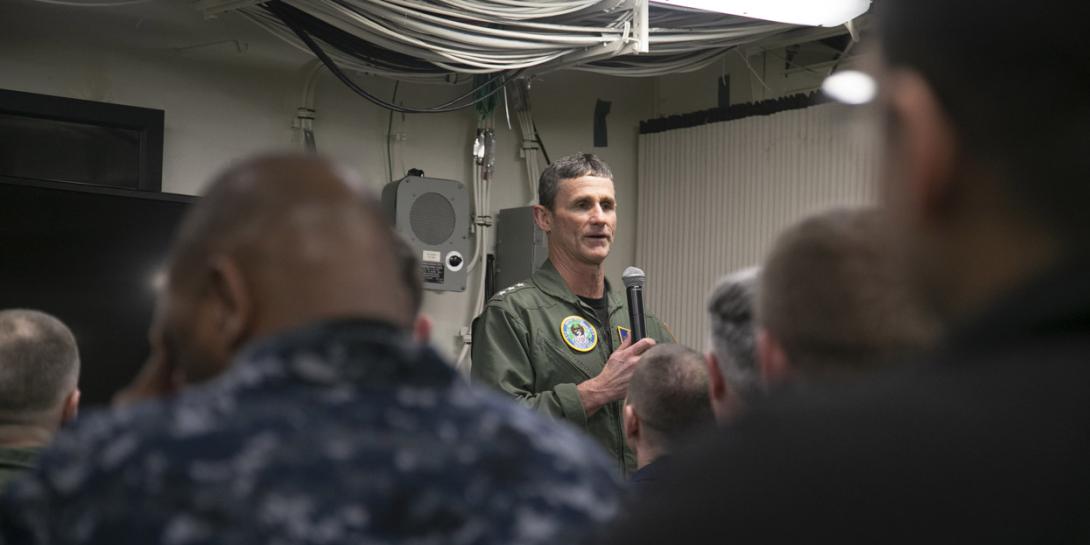Cold Water Operations Take Precedence
The United States and NATO are facing greater threats from the Russian Federation, and a growing interest from China, in the waters of the North Atlantic and the Arctic, warned Vice Adm. Andrew “Woody” Lewis, USN, who spoke Tuesday at AFCEA International and IEEE’s MILCOM conference in Norfolk, Virginia.
The dual-hatted commander oversees both the U.S. Navy’s Second Fleet and NATO’s new Joint Force Command Norfolk. To combat rising threats and provide stability, both commands must improve their operational abilities in these northern waters, he said.
VADM Lewis, @USNavy, Cmdr @US2ndFleet and Cmdr Joint Forces Command Norfolk @NATO: The reestablished 2nd Fleet is focused on how great power competition manifests in maritime operations, in the Atlantic & Arctic. "It's an increasingly lethal and disruptive battlespace." #MILCOM pic.twitter.com/1BampcxB88
— Kimberly Underwood (@Kunderwood_SGNL) November 12, 2019
The creation of NATO’s new command in the same year as the reestablishment of the Second Fleet was no coincidence. NATO leaders recognized the same shift in the Atlantic/Arctic threat environment and stood up the Joint Force Command Norfolk as part of their revamped NATO command structure.
“We have not stood up a NATO Command in the United States in a long, long time, and we have never stood up a command of this nature,” Adm. Lewis stressed. “It's a hybrid command within NATO Command structure. My priority has been ensuring that both commands are built in such a way that they are fully aligned and complementary.”
Once fully operational, the U.S. Second Fleet will operate in the waters from the East Coast of the United States to the Arctic, “inclusive of Iceland, Norway and the approaches of the Baltic and the Azores,” Adm. Lewis offered.
NATO’s Joint Force Command Norfolk is roughly a year and nine months behind the Second Fleet. “Joint Force Command Norfolk will work with allies and partners to deter aggressive behavior of the Russian Federation in the North Atlantic,” the commander said.
Russia, however, considers itself the great power in the Arctic and China is certainly interested in hydrocarbon and fishing developments in those waters, the admiral explained. “If we do not get in the Arctic with a measured and deliberate approach, the area is destined for conflict,” Adm. Lewis warned. “The U.S. and Allied presence now, both naval and economic, in the Arctic could mean a peaceful cooperative environment.”
To improve its capabilities, the United States is turning to allies with experience operating in the North Atlantic, such as Canada. “We must look to our partners as experts in this arena and learn from them,” Adm. Lewis emphasized. One key appointment is having Rear Adm. Steve Waddell, Royal Navy of Canada, as second in charge at the fleet. The vice commander confirmed that he was brought in to aid U.S. naval and NATO operations in Northern waters. “The first step was inviting a partner who has operated in that environment a little more, down to the team,” Adm. Waddell stated. “Through necessity and based on geography, the Canadian Navy has operated in that austere expeditionary environment, more so, I’ve learned, than the U.S. Navy service fleet.”
Rear Adm. Waddell, @RoyalCanNavy vice commander @US2ndFleet is helping to bring in understanding of operating in the North Atlantic, building a partnership perspective to coordinate effects in that environment, if ever there is a potential fourth battle of the Atlantic #MILCOM pic.twitter.com/Xyp9X2p9Wp
— Kimberly Underwood (@Kunderwood_SGNL) November 12, 2019
However, Adm. Lewis acknowledged that the reality of military operations for many nations over the years meant they were operating in the Arabian Sea, the Persian Gulf or the Asian Pacific. With the growing importance of the Arctic environment, he said, they all must build more experience.
“It will take some time for us to build a muscle memory of operating cold weather environments like we did 30-plus years ago, but we won't get there unless we physically place ourselves in the region, participating in exercises, and learning alongside our allies and partners in deployments and exposing our team to that environment,” Adm. Lewis said.





Comments